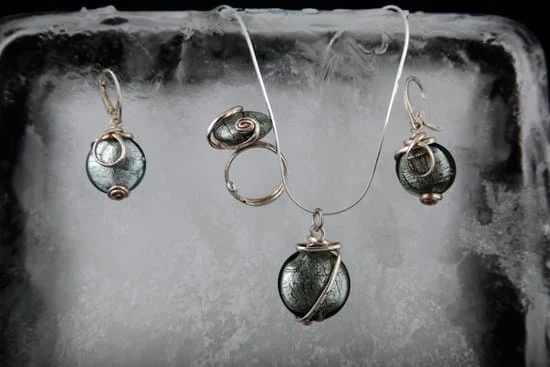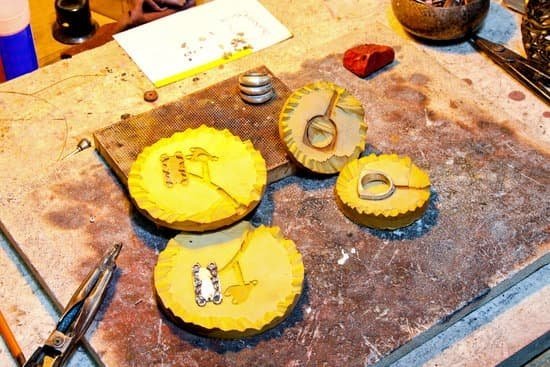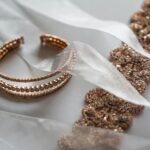Diamonds are synonymous with luxury and elegance, adding a touch of brilliance to any piece of jewelry. Whether you’re a jewelry enthusiast looking to enhance your collection or someone interested in creating their own personalized diamond pieces, understanding how to put diamonds in jewelry is a valuable skill. In this article, we will explore the timeless allure of diamond jewelry and the significance that diamonds hold in accessorizing.
Diamonds have long been revered for their beauty and rarity. Their dazzling sparkle and fire make them the perfect centerpiece for any piece of jewelry, from engagement rings to necklaces and earrings. The mesmerizing charm of diamond jewelry has captivated people for centuries, and they continue to be a symbol of wealth, love, and opulence.
The process of putting diamonds in jewelry starts with understanding the quality factors that determine a diamond’s value. The four C’s – cut, color, clarity, and carat weight – play a crucial role in choosing the right diamond for your desired piece. By familiarizing yourself with these factors, you can make informed decisions when selecting diamonds based on personal preferences and budget.
So whether you’re planning to create your own masterpiece or simply want to appreciate the artistry behind diamond jewelry design, this article will guide you through each step of the process. From understanding diamond quality to choosing the perfect setting and acquiring necessary tools and materials, we will provide comprehensive insight into how to put diamonds in jewelry while ensuring proper handling and maintenance techniques.
Get ready to unleash your creativity and elevate your passion for diamonds with our expert tips and tricks.
Understanding the 4 C’s
When it comes to buying diamonds for jewelry, understanding the four key factors that determine their quality is essential. These factors, commonly known as the 4 C’s – cut, color, clarity, and carat weight – play a significant role in determining a diamond’s value and overall appearance.
Firstly, let’s delve into the importance of cut. The cut refers to how well a diamond has been shaped and faceted. It affects how efficiently light passes through the stone, thus directly impacting its brilliance and sparkle. A well-cut diamond will reflect light beautifully and appear more radiant. On the other hand, a poorly cut diamond may lose much of its potential shine.
Next is color. While many assume that diamonds are purely colorless, this isn’t always the case. Diamonds can fall within different color grades ranging from D (colorless) to Z (light yellow or brown). Generally speaking, the higher the color grade, the more valuable and rarer the diamond is.
Clarity is another vital aspect to consider when evaluating a diamond’s quality. Clarity refers to any internal or external imperfections or blemishes in the stone. These imperfections are called inclusions if they occur internally, or blemishes if they occur externally. Diamonds are graded on a scale from Flawless to Included (I1-I3), with Flawless diamonds being free of any visible flaws.
Lastly, carat weight determines the size of a diamond. Although carat weight directly impacts price and perceived value, it is important to note that two diamonds of equal carat weight can have vastly different prices due to differences in their other quality factors.
When selecting diamonds for your jewelry pieces, understanding these four factors will enable you to make informed decisions based on personal preferences and budget constraints. Whether you prioritize brilliance over size or desire a perfectly colorless stone, having a grasp of the 4 C’s will help you navigate the vast world of diamond quality.
Choosing the Perfect Setting
When it comes to creating stunning diamond jewelry, choosing the perfect setting is essential to showcase the beauty and brilliance of diamonds. The right setting not only enhances the overall aesthetic appeal but also ensures that the diamonds are securely held in place. In this section, we will provide a comprehensive guide to different types of jewelry settings that can be used to showcase diamonds in style.
There are various types of settings available, each with its own unique characteristics and advantages. One popular option is the prong setting, which uses small metal prongs to hold the diamond securely in place while allowing maximum light exposure for optimal sparkle. Another option is the bezel setting, where a metal rim surrounds the diamond, providing both protection and an elegant, sleek look.
For those who prefer a more intricate design, pave settings feature multiple small diamonds set close together to create a “paved” appearance. This setting creates a stunning shimmering effect and can be used as an accent or to cover larger areas of jewelry. Other common settings include channel settings, where diamonds are held between two metal channels, and tension settings that use pressure to hold the diamond in place without any visible prongs or bezels.
When selecting the ideal setting for your diamond jewelry piece, there are several factors to consider. First and foremost is personal preference – choose a design that appeals to your individual style and taste. Additionally, consider the durability and practicality of the setting. If you plan on wearing your jewelry every day or engaging in activities that may subject it to more wear and tear, a sturdier setting like a bezel or channel may be more suitable.
Lastly, think about how well the chosen setting will complement the shape and size of your diamond. Certain settings may flatter specific shapes better than others. For example, round brilliant cut diamonds tend to look stunning in prong or pave settings since they enhance their natural sparkle. On the other hand, an emerald-cut diamond may be better showcased in a step-cut setting that highlights its clean lines and distinct facets.
By carefully considering the different types of settings available and taking into account personal preferences and diamond characteristics, you can choose the perfect setting to showcase your diamonds in style. Whether you opt for a classic prong or want to experiment with a more unique pave or tension setting, selecting the right setting adds an extra touch of elegance and sophistication to your diamond jewelry.
Preparing Your Jewelry
To successfully add diamonds to your jewelry pieces, it is essential to have the right tools and materials. Whether you are a professional jeweler or an enthusiastic hobbyist, having the proper equipment will ensure that your diamond setting process goes smoothly and yields beautiful results. Here is a practical overview of the tools and supplies you will need:
- Diamond Tweezers: These specialized tweezers have fine tips that allow for precise handling of diamonds. It is important to choose tweezers made from a non-magnetic material, such as stainless steel, to prevent any unwanted attraction between the tweezers and the diamonds.
- Setting Bur: A setting bur is a small rotary tool attachment that is used to create space in the metal for the diamond to be set. The size of the bur should correspond to the size of your diamond, so it is crucial to select the appropriate bur for your project.
- Bezel Pusher or Burnisher: This tool is used to secure diamonds in bezel settings by carefully pushing or burnishing the metal against the stone. There are different types of bezels pushers available, so choose one that suits your preferences and specific setting style.
- Adhesive: Depending on the type of jewelry piece you are working on, you may require adhesive to securely hold diamonds in place. Epoxy or jewelers’ glue specifically designed for jewelry-making are commonly used adhesives in diamond setting.
- Loupe or Magnifying Glass: A magnification tool such as a loupe is indispensable when working with diamonds due to their small size and intricate details. A good-quality 10x loupe will aid you in examining facets, clarity characteristics, and overall quality.
In addition to these tools, it is imperative to acquire high-quality diamonds from reputable sources to ensure their authenticity and superior quality. Look for certified diamonds that come with detailed grading reports from reputable gemological laboratories such as the Gemological Institute of America (GIA) or the American Gem Society (AGS). The grading reports will provide comprehensive information about the diamond’s characteristics, including cut, color, clarity, and carat weight.
Having the right tools and materials adds to the precision and success of your diamond setting endeavors. Investing in high-quality equipment will not only make the setting process more efficient but also contribute to the longevity and overall value of your finished jewelry piece.
Precautions and Safety Measures
Diamonds are not only beautiful and luxurious, but they are also valuable and delicate gemstones. As such, it is crucial to follow precautions and safety measures when handling these precious stones to ensure their integrity and minimize the risk of damage or loss. This section will provide some essential guidelines for safely working with diamonds in jewelry.
Safety Guidelines for Handling Diamonds
When working with diamonds, it is important to take certain precautions to protect both yourself and the gemstone. Here are some safety guidelines to keep in mind:
- Use protective gloves: Wear clean, lint-free gloves made of latex or nitrile to prevent smudging or scratching the diamond. This is particularly important when handling loose diamonds.
- Clean work area: Ensure that your work surface is clean and free from any debris or potential hazards that could damage the diamond.
- Work with a soft cloth or pad: Place a soft cloth or jeweler’s pad on your work surface to cushion the diamond while handling it.
Minimizing the Risk of Accidents
Accidents can happen even under the most careful circumstances, so it’s important to take extra precautions to minimize the risk of accidents when working with diamonds. Consider the following tips:
- Adequate lighting: Make sure you have sufficient lighting in your workspace, as this will help you see small details more clearly and reduce the risk of mishandling diamonds.
- Secure setting: If you are setting a diamond into a piece of jewelry, ensure that the setting is secure before proceeding further. A loose setting can result in a lost or damaged diamond.
- Handle with tweezers or prongs: When picking up or moving a diamond, use tweezers specifically designed for holding gems or pronged tweezers. This will provide better grip and control over the gemstone.
By following these precautions and safety measures, you can ensure the proper handling of diamonds, protecting their value and beauty throughout the jewelry making process. Remember, safety should always be a top priority when working with any valuable or delicate materials.
Step-by-Step Guide
Adding diamonds to jewelry is a meticulous process that requires precision and care. Whether you are a beginner or an experienced jeweler, following a step-by-step guide can ensure successful diamond setting.
Step 1: Gather the Tools
Before you begin, make sure you have all the necessary tools and materials at hand. These may include:
- Jewelers’ loupe or magnifying glass: This will help you examine the diamonds closely for any flaws or inclusions.
- Diamond tweezers: These specialized tweezers have a fine tip that allows for precise handling of small diamonds.
- Jewelry files and burrs: These tools are used to shape the metal setting and create grooves for holding the diamonds securely.
- Jewelers’ torch or soldering iron: You may need these tools if your jewelry piece requires soldering to attach the diamond setting.
- Adhesive or epoxy: This is used to secure diamonds in settings that do not require prongs or other traditional methods of holding them in place.
Step 2: Choose the Right Setting
Selecting the appropriate setting is crucial as it determines how your diamonds will be showcased. Some common types of settings include:
- Prong setting: This classic setting uses metal prongs to hold the diamond securely while allowing maximum light to pass through, enhancing its brilliance.
- Bezel setting: In this type of setting, a thin strip of metal encircles the diamond, providing a secure fit with added protection.
- Pave setting: Multiple small diamonds are set close together, creating an appearance of continuous sparkle on the jewelry surface.
Consider factors such as the size and shape of your diamond, along with personal style preferences when choosing the perfect setting.
Step 3: Execute with Precision
Carefully follow these steps when adding diamonds to your jewelry:
- Prepare your work area: Ensure you have a clean, well-lit workspace to facilitate accurate diamond placement.
- Mark the position: Use a sharp tool or pencil to mark where each diamond will be placed on your jewelry piece.
- Set the prongs or bezel: If using prongs, carefully position them over the marked spots and secure them tightly around the diamonds. For bezel settings, bend the metal strip around the diamond and ensure a snug fit.
- Secure with adhesive (if needed): Apply a small amount of adhesive or epoxy to hold the diamonds in place if your chosen setting does not rely solely on prongs or bezels.
- Clean and polish: Once all diamonds are securely set, clean the jewelry piece thoroughly to remove any excess adhesive or dirt that may have accumulated during the setting process.
Remember, patience and practice are key when learning how to add diamonds to jewelry. With each successful attempt, your confidence and skills will grow, allowing you to create stunning diamond pieces that showcase your artistic vision.
Maintaining Diamond Jewelry
Diamond jewelry is not only a valuable investment but also a symbol of luxury and elegance. To keep your diamond pieces looking their best, it is essential to properly clean and care for them. This section will provide expert advice on maintaining diamond jewelry, including effective cleaning techniques and tips for long-term preservation of their brilliance.
Cleaning Your Diamond Jewelry
Cleaning diamond jewelry regularly is crucial to maintain its sparkle and shine. However, it is important to use gentle methods that do not damage the stones or their settings. Here are some effective cleaning techniques:
- Use a Soft Toothbrush: Gently brush your diamond pieces with a soft-bristled toothbrush to remove any dirt or residue. Be sure to reach into crevices and underneath the diamonds where grime can accumulate.
- Soak in Warm Soapy Water: Prepare a mixture of warm water and mild dish soap. Place your diamond jewelry in the solution and let it soak for 15-20 minutes. After soaking, gently scrub the jewelry with the toothbrush, paying special attention to the diamond.
- Rinse Thoroughly: Rinse the jewelry under warm running water to remove any remaining soap residue. Ensure that all traces of soap are washed away as they can dull the shine of your diamonds.
- Pat Dry with a Soft Cloth: Use a lint-free cloth or a microfiber towel to gently pat dry your diamond jewelry after washing. Avoid rubbing too hard as this may scratch the metal or loosen prongs.
Caring for Your Diamond Jewelry
In addition to regular cleaning, proper care is essential in preserving the brilliance and longevity of your diamond jewelry. Here are some tips for caring for your precious pieces:
- Avoid Harsh Chemicals: Keep your diamond jewelry away from harsh chemicals such as bleach, chlorine, and household cleaning products. These chemicals can damage both the diamonds and their settings.
- Store Separately: Diamonds are extremely hard and can scratch other gemstones or metals. To prevent scratching, store your diamond jewelry separately in soft fabric pouches, jewelry boxes with individual compartments, or lined jewelry trays.
- Professional Inspection: Have your diamond jewelry inspected by a professional jeweler at least once a year. They will check for loose prongs, damaged settings, or any other issues that may require repair.
- Remove During Activities: Avoid wearing diamond jewelry during activities such as gardening, exercising, or swimming. These activities can expose the diamonds to dirt, sweat, and potential damage.
By following these cleaning and care tips, you can ensure that your diamond jewelry remains dazzling and pristine for years to come. Remember that proper maintenance not only enhances the longevity of your precious pieces but also allows them to continue shining brilliantly on any occasion.
Expert Tips and Tricks
When it comes to diamond jewelry, there are endless opportunities to elevate your designs and create pieces that truly stand out. In this section, we will explore some expert tips and tricks to help you take your diamond jewelry game to the next level.
One of the most innovative ways to enhance your diamond jewelry is by incorporating other gemstones alongside diamonds. By pairing diamonds with different colored gemstones, you can create a stunning contrast and add depth to your designs. For example, combining diamonds with sapphires can create a classic and elegant look, while pairing them with rubies or emeralds adds a vibrant touch. The key is to find gemstones that complement the color of your diamonds and achieve the desired aesthetic effect.
An important aspect of designing captivating diamond jewelry is considering the overall composition of the piece. Experimenting with different shapes and arrangements of diamonds can result in unique and eye-catching designs. For example, instead of using a single large diamond as the centerpiece, consider creating a cluster effect by using smaller diamonds arranged in an intricate pattern. This technique not only adds visual interest but also allows for more flexibility in terms of design options.
Additionally, don’t be afraid to think beyond traditional settings when it comes to displaying diamonds in your jewelry. Exploring unconventional setting styles such as tension or channel settings can give your pieces a modern and contemporary look.
These settings allow for a sleek and minimalistic appearance while still showcasing the brilliance of the diamonds. Remember that craftsmanship plays a crucial role in achieving remarkable jewelry pieces, so partnering with skilled artisans or investing time in honing your own skills can greatly impact the final outcome.
By following these expert tips and tricks, you can elevate your diamond jewelry game and create dazzling pieces that truly reflect your artistic vision. Remember that experimentation is key when it comes to designing exceptional jewelry, so don’t be afraid to push boundaries and think outside the box. Whether you’re a professional jeweler or a passionate DIY enthusiast, let your creativity soar and unleash the full potential of diamonds in your designs.
Conclusion
In conclusion, diamonds are truly the epitome of beauty and elegance in jewelry. They have a timeless allure that never fails to captivate and add a touch of sophistication to any outfit. Throughout this article, we have explored various aspects of putting diamonds in jewelry, from understanding the 4 C’s to choosing the perfect setting and maintaining diamond jewelry.
By delving into the four key factors that determine a diamond’s quality, we have equipped ourselves with the knowledge needed to select the right diamond based on personal preferences and budget. Additionally, our comprehensive guide to different types of jewelry settings has provided insights on how to showcase diamonds in style and accentuate their brilliance.
It is important to remember that proper handling and care is essential when working with diamonds. We have discussed safety measures and precautions to ensure that diamonds are handled safely, minimizing the risk of accidents or damage. Furthermore, expert advice on cleaning and maintenance has been shared to help preserve the brilliance and longevity of diamond jewelry.
Now armed with valuable information on adding diamonds to jewelry, it is time for readers to unleash their artistic vision. The possibilities are endless when it comes to designing personalized diamond jewelry pieces. Whether it be combining diamonds with other gemstones or experimenting with unique settings, embracing the art of diamond setting allows for creativity and self-expression.
Frequently Asked Questions
How do you put a diamond in a ring at home?
Putting a diamond in a ring at home requires some expertise and tools, so it’s generally recommended to leave this task to professional jewelers. However, if you have previous experience or are confident in your skills, you can attempt it with caution. The process involves carefully selecting a diamond that fits the ring setting, ensuring the prongs or metal claws are intact and aligned properly, removing any existing stones if necessary, and gently positioning the diamond within the setting.
It is crucial to handle the diamond with extreme care, using tweezers or specialized gem-setting tools to avoid damaging it. Finally, secure the stone by tightening the prongs or bezel securely around the diamond.
Are diamonds glued to jewelry?
In most cases, diamonds are not glued to jewelry. Diamonds are typically set using prongs, also known as claws, which hold the stone securely in place. These prongs are created from metal and are meticulously bent over each facet of the diamond to prevent it from falling out of its setting.
This traditional method ensures maximum visibility of the diamond’s facets and allows light to pass through for optimal brilliance. However, there may be some instances where glue is used temporarily during repairs or to secure smaller accent diamonds on certain types of jewelry.
How much does it cost to set a diamond in a ring?
The cost of setting a diamond in a ring can vary widely depending on several factors such as the type of ring setting chosen and whether any additional customizations are required. Factors like metal type (e.g., gold, platinum), complexity of design, jeweler’s expertise/experience level, and location can also influence pricing. Generally speaking, prices range anywhere from $50 to several hundred dollars for simple prong settings for small-sized diamonds without any intricate designs or customization requests.
However, intricate settings like pave or halo styles can cost more due to their complex nature and additional labor involved. For larger diamonds or more elaborate custom designs that involve extensive craftsmanship, prices can increase significantly into the thousands of dollars. It is advisable to consult with a reputable jewelry store or professional jeweler for an accurate cost estimate based on your specific requirements.

Welcome to my jewelry blog! My name is Sarah and I am the owner of this blog.
I love making jewelry and sharing my creations with others.
So whether you’re someone who loves wearing jewelry yourself or simply enjoys learning about it, be sure to check out my blog for insightful posts on everything related to this exciting topic!





